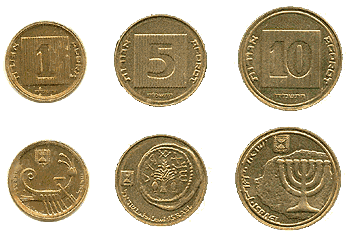
Israeli agora
Encyclopedia

Denomination (currency)
Denomination is a proper description of a currency amount, usually for coins or banknotes. Denominations may also be used with other means of payment like gift cards. See also Redenomination.-Subunit and super unit:...
of the currency
Currency
In economics, currency refers to a generally accepted medium of exchange. These are usually the coins and banknotes of a particular government, which comprise the physical aspects of a nation's money supply...
of Israel
Israel
The State of Israel is a parliamentary republic located in the Middle East, along the eastern shore of the Mediterranean Sea...
. The Israeli currency - the new Israeli shekel (NIS) is divided into 100 agorot.
The name agora actually refers to three kinds of currencies that were used in Israel throughout its history, all of them have been subdivisions of the main currency units.
This name was used for the first time in 1960, when the Israeli government decided to change the subdivision of the Israeli lira (a.k.a Israeli pound) from 1000 prutot
Israeli pruta
The Pruta was a denomination of currency in Israel prior to 1960.The pruta was introduced shortly after the establishment of the state of Israel, as the 1000th part of the Israeli pound...
to 100 agorot. The name was suggested by the Academy of the Hebrew Language
Academy of the Hebrew Language
The Academy of the Hebrew Language was established by the Israeli government in 1953 as the "supreme institution for scholarship on the Hebrew language."-History:...
, and was borrowed from the Hebrew Bible
Bible
The Bible refers to any one of the collections of the primary religious texts of Judaism and Christianity. There is no common version of the Bible, as the individual books , their contents and their order vary among denominations...
, I Samuel 2:36 ...every one that is left in thine house shall come and crouch to him for a piece of silver... (the term "piece of silver" appears in Hebrew as "agorat kessef").
In 1980 the Israeli lira was abolished and replaced by the shekel at a rate of 10 IP per 1 shekel. The new subdivision of the shekel was named agora ħadasha ("new agora"). There were 100 new agorot in 1 shekel. The high rate of inflation in Israel in the early 1980s forced the Israeli government to change the Israeli currency once again in 1985. The new shekel was introduced at a rate of 1000 S per 1 NS. The name agora was used once again for its subdivision. This time the term "new" was avoided, in order to prevent confusion with the older subdivision (the pre-1980 agora was long since out of circulation).
Currently, the term agora refers to the 100th part of the new shekel. There are coins of 10 and 50 agorot, though the 50 agorot coin bears the inscription: "½ New Shekel".
A coin of 1 agora was in use until April 1, 1991 a coin of 5 agorot was in use until January 1, 2008 when the Bank of Israel
Bank of Israel
The Bank of Israel is the central bank of Israel. It is located in Kiryat HaMemshala in Israel's capital city of Jerusalem, with a branch office in Tel Aviv. The current governor is Stanley Fischer.-History:...
decided to take them out of circulation. This was due to the costs spent on its production which considerably exceeded the coin's value. Today, when paying in cash, the price must be rounded to the nearest multiple of 10 agorot. When buying several items, the rounding is done for the total sum. There is no rounding when paying in cheques, credit cards or bank orders.

